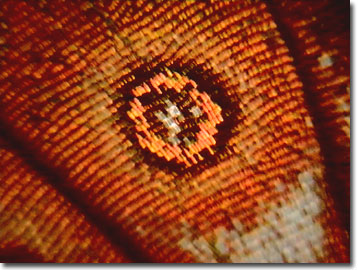Butterfly Wing Scale Digital Image Gallery
Common Morpho Butterfly
Although called the common morpho butterfly, this brilliant blue Neotropical lepidopteran with jewel-like iridescent wings appears anything but common. Members of the species have an uncommonly long lifespan, sometimes surviving more than nine months. However, territorial males can be easily lured to capture by flashing blue, shiny paper and may not live as long in captivity.

As with other morpho butterflies, only the upper sides of the paired wings feature the brilliant blue hue. The unusual wing color is based on light reflection and refraction, not pigments. The undersides of the wings, which are displayed while the butterfly is at rest with its wings up, are shades of brown and tan. The earth tones help the butterfly blend in with the twigs, branches, and tree trunks of the tropical forest. Also beneficial to their survival is the fact that common morphos fly very slowly, only showing the blue color of their wings sporadically. To a pursuing predator, the brilliant blue lepidopteran seems to disappear in mid-flight.
The common morpho larvae are the source of another name of the species scientifically described as Morpho peleides. The young caterpillars are conspicuously yellow and red and are covered with dense hairs. The heads of common morpho caterpillars appear like red crowns, which results in their additional moniker, emperor morpho butterflies. The larvae feed in groups upon plants, such as mimosa, but are also cannibalistic. Caterpillars in their final stage of transformation are characterized by fine red, black, and brown lines, and red and white hairs that cover their bodies, forming tufts along their backs and sides. The tiny hairs on the bodies of the larvae irritate human skin and result in a painful rash when touched.
Prized by butterfly collectors, artists, craft makers, and by souvenir-seeking tourists, a great number of common morphos are marketed each year. Commercial butterfly hunters learn their preferred travel routes and are able to bait potential specimens with rotting fruit, sweetened with additional sugary liquids. Females, however, are more difficult to catch in the wild than males because they usually do not stray from the rainforest canopy. Their scarcity results in a commanding price for the larger, wild female specimens, which may be twenty times more expensive than males.
Common Morpho Butterfly Images in Reflected Light
Wing Marking (High Magnification) - This is a high magnification image of the wing scales displayed in the photomicrograph presented above. The brown and tan coloration indicates that this is an example of a marking on the underside of a common morpho butterfly wing.
Contributing Authors
Cynthia D. Kelly, Shannon H. Neaves, Laurence D. Zuckerman, and Michael W. Davidson - National High Magnetic Field Laboratory, 1800 East Paul Dirac Dr., The Florida State University, Tallahassee, Florida, 32310.
BACK TO THE BUTTERFLY WING SCALE IMAGE GALLERY
BACK TO THE DIGITAL IMAGE GALLERIES
Questions or comments? Send us an email.
© 1995-2025 by Michael W. Davidson and The Florida State University. All Rights Reserved. No images, graphics, software, scripts, or applets may be reproduced or used in any manner without permission from the copyright holders. Use of this website means you agree to all of the Legal Terms and Conditions set forth by the owners.
This website is maintained by our
Graphics & Web Programming Team
in collaboration with Optical Microscopy at the
National High Magnetic Field Laboratory.
Last Modification Friday, Nov 13, 2015 at 01:19 PM
Access Count Since January 21, 2003: 25801
Visit the website of our partner in introductory microscopy education:
|
|
